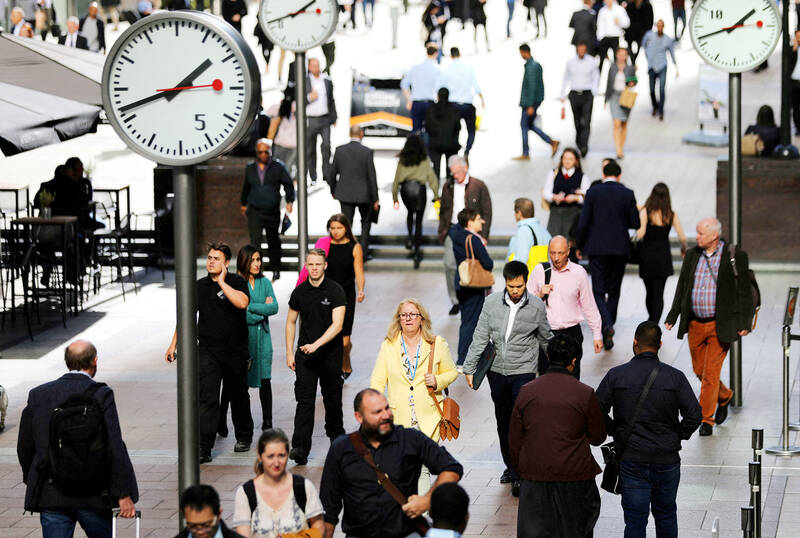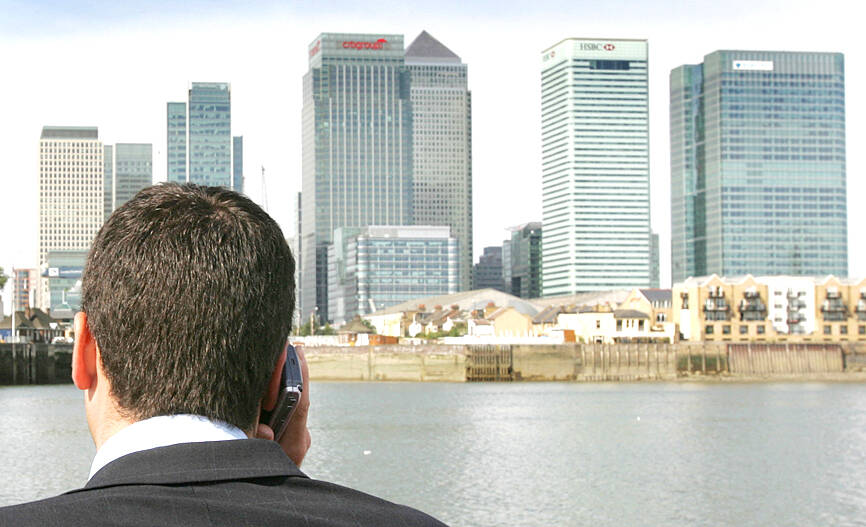City of London workers looking to save money may want to embrace the office over winter as the cost of working from home soars alongside energy bills.
Those prepared to go into the office every day could save about €50 (US$60) per week in January 2023 if they can walk, run or cycle into their workplace. That’s thanks to the money they’ve saved by not heating a home for the whole day, according to estimates by price comparison site Uswitch.
Those working from home in January could expect to pay around €175 a week in energy costs and other incidentals included in Bloomberg’s calculations such as buying in your own coffee, a freebie in many offices. The combined cost of energy bills — factoring in the lower consumption expected — and five return trips on the Tube from London’s Zone 4 would be about €160 a week in January 2023, a €15 saving.

Photo: Reuters 照片:路透
For those taking the bus, the total cost is about €140, a €35 weekly saving. In both cases, any rise in the cost of the commute will eat into those savings.
Uswitch estimates that the average monthly energy bill could hit €683 in January for home workers, compared to €492 for those heading to the office. It assumes remote workers use 25 percent more electricity and 75 percent more gas per day including from central heating.
Coping Mechanism

Photo: Reuters 照片:路透
“People are going to be really struggling to heat their own homes and they are going to look for warmth in other places — we know that is a coping mechanism that people use, whether that is going to a public space, such as a library or a church maybe, or whether it’s going to work when you usually would work from home” Matt Copeland, policy officer at National Energy Action said. “Those are the options people will consider and people will take to actually find warmth.”
The incentive to come into the office is likely to be welcomed by some in the City of London, where finance bosses have been pushing for a return to the office. Right now less than half of workers in the UK’s banking sector go into the office on an average day, and just 18 percent of insurance sector employees do so, according to a survey by consultancy Advanced Workplace Associates.
(Bloomberg)
在家工作的成本隨著能源費用的飆升一起上漲,因此到了冬天,想要省錢的倫敦城上班族可能會希望進辦公室上班。
準備每天去辦公室的人若可以走路、跑步或騎自行車到工作地點的話,在二○二三年一月,每週可節省約五十英鎊(六十美元)。根據價格比較網站Uswitch的估計,他們之所以省下這些錢,是因為家裡整天都不開暖氣。
一月份在家工作的人預計每週要支付大約一百七十五英鎊的能源費用,以及彭博社所計算出的其他雜費,例如自費買咖啡——很多辦公室會免費供應咖啡。二○二三年一月能源帳單的總成本(以預期較低的花費計算),加上由倫敦第四區坐地鐵來上班來回五次,每週將花費約一百六十英鎊,因此跟在家工作相比,到辦公室上班節省了十五英鎊。
坐公車上班的人,總花費則約為一百四十英鎊,每週可節省三十五英鎊。在坐地鐵和公車這兩種情況下,任何通勤成本的增加都會消耗所省下的錢。
Uswitch估計,在家工作的人,一月份的平均能源費用可能會達到六百八十三英鎊,而到辦公室上班的人則為四百九十二英鎊。這是假設遠距上班的人每天多使用百分之二十五的電力,以及多百分之七十五的瓦斯,包括用於中央暖氣。
因應機制
「要把自己家裡變暖將是難以負擔的窘境,所以人們會到其他地方取暖——我們知道這是一種因應機制,無論是去公共場所,比如圖書館或教堂,或是在你通常在家工作的時候到辦公室上班」,國家能源行動組織政策主管馬特‧科普蘭表示。「人們會考慮和採用這些選項,而實際上找到暖源」。
對於這進辦公室的動機,倫敦城某些人可能會樂見其成。這些金融業老闆一直在推動員工重返辦公室。根據諮詢公司Advanced Workplace Associates的一項調查,目前英國銀行業平均只有不到一半的員工進辦公室上班,而保險業只有百分之十八的員工這麼做。
(台北時報林俐凱編譯)

本文由生成式AI協作,本刊編輯編修。 The name of a dish often provides clues about what to expect. Names can paint a vivid picture, but they may also be misleading when they have little to do with what’s actually on the plate. Some people have shared their personal experiences of such dishes on social media. (A) Dolly I’ll never forget the sense of betrayal I felt when I first ate Taiwan’s pineapple cake because there was barely any pineapple inside! When I questioned the store clerk, she explained that early pineapple cakes blended winter melon with pineapple to reduce acidity. Many producers now eliminate the sour fruit entirely

A: According to the Ministry of Sports, 35.3 percent of the Taiwanese exercise regularly in line with the “7-3-3-3” principle. B: The “7-3-3-3” principle? A: It means exercising more than three times a week, for over 30 minutes each time – with a heart rate of 130bpm, sweating and breathing heavily during exercise. B: I go swimming at least three times a week. I’m even going to the 2025 Sun Moon Lake International Swimming Carnival in Nantou next Sunday. A: Wow, you’re such a fitness enthusiast. I’ll go cheer you on, then. A: 根據運動部的「7-3-3-3」原則,台灣人規律運動比例達35.3%。 B: 什麼是「7-3-3-3」原則?

本文由生成式AI協作,本刊編輯編修。 Continued from yesterday(延續自昨日) https://www.taipeitimes.com/News/lang (D) Bonnie I was so confused when I was offered black pudding in the UK. I was expecting a sweet dessert, but it’s a type of blood sausage made mainly from pork blood, fat, and oatmeal, giving it a dark black color. The word “pudding” in its Latin meaning refers to sausage rather than dessert. (E) Lance When I saw the name Lion’s Head at a Chinese restaurant, I thought they served real lion meat and hesitated to order it. However, I learned from the waiter that the dish is composed of large meatballs surrounded by vegetables. Its name comes from

Day and night will get equal time for a brief moment on Tuesday as much of the world heads into fall. The autumnal equinox arrives Tuesday, marking the start of the fall season for the Northern Hemisphere and the spring in the Southern Hemisphere. On the equator, the sun will be directly overhead at noon. Equinoxes are the only times when both the north and south poles are lit by sunshine at the same time. In the Northern Hemisphere, sunlight will gradually diminish each day until the winter solstice on Dec. 21. Equinoxes have been marked and celebrated worldwide for centuries. The fall